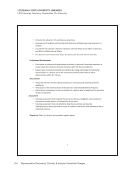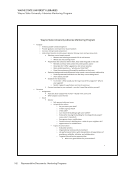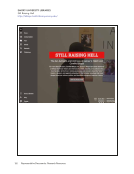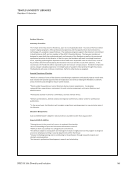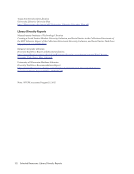8 Survey Results: Survey Questions and Responses
Survey Questions and
Responses
The SPEC Survey on Diversity and Inclusion was designed by Toni Anaya, Instruction Coordinator, and
Charlene Maxey-Harris, Research and Instructional Services Chair, at the University of Nebraska-Lincoln.
These results are based on responses from 68 of the 124 ARL member libraries (55%) by the deadline of
June 12, 2017. The survey’s introductory text and questions are reproduced below, followed by the response
data and selected comments from the respondents.
Since the SPEC survey program began in the early 1970s, at least six surveys have investigated how
research libraries responded to affirmative action initiatives, recruited minorities, and, more recently,
attempted to build an inclusive workforce that reflects the broad diversity of their communities.
The resulting SPEC Kits provide a wealth of information about library hiring programs and services,
recruitment and retention strategies, and efforts to foster diversity with the workforce. They also show
that the issues have been in constant flux. While the focus of earlier surveys was on how successful
libraries have been in recruiting and retaining librarians of color, the characteristics of diversity now
extend beyond racial and ethnic groups to include gender, sexual orientation, ability, language, religious
belief, national origin, age, and ideas.
The increase of published literature about cultural competencies, microaggressions, and assessment of
diversity issues, as well as the inclusion of social justice movements in libraries, suggests diversity-related
activities have increased and evolved since 2010, when ARL published SPEC Kit 319 Diversity Plans
and Programs. During the last seven years, several libraries have obtained funding to support strategies
to increase the number of minority librarians on their staff and support their advancement within the
organization. There also appears to be an increase in the number of diversity and inclusion or social
justice committees, task forces, and project teams at the local, state, and national levels. In addition,
libraries and archives are evaluating the extent to which collection development strategies, exhibitions,
descriptive practices, student and community outreach activities, and other activity can support the
creation of inclusive environments. However, these changes have not been consistently documented.
Therefore, it is important to re-examine research libraries’ efforts to create a more representative
workforce and inclusive work environment.
The purpose of this survey is to explore the components of diversity plans created since 2010, identify
current recruitment and retention strategies that aim to increase the number of minority librarians
in research libraries, identify staff development programs that foster an inclusive workplace and
climate, identify how diversity programs have changed, and gather information on how libraries assess
these efforts.
Survey Questions and
Responses
The SPEC Survey on Diversity and Inclusion was designed by Toni Anaya, Instruction Coordinator, and
Charlene Maxey-Harris, Research and Instructional Services Chair, at the University of Nebraska-Lincoln.
These results are based on responses from 68 of the 124 ARL member libraries (55%) by the deadline of
June 12, 2017. The survey’s introductory text and questions are reproduced below, followed by the response
data and selected comments from the respondents.
Since the SPEC survey program began in the early 1970s, at least six surveys have investigated how
research libraries responded to affirmative action initiatives, recruited minorities, and, more recently,
attempted to build an inclusive workforce that reflects the broad diversity of their communities.
The resulting SPEC Kits provide a wealth of information about library hiring programs and services,
recruitment and retention strategies, and efforts to foster diversity with the workforce. They also show
that the issues have been in constant flux. While the focus of earlier surveys was on how successful
libraries have been in recruiting and retaining librarians of color, the characteristics of diversity now
extend beyond racial and ethnic groups to include gender, sexual orientation, ability, language, religious
belief, national origin, age, and ideas.
The increase of published literature about cultural competencies, microaggressions, and assessment of
diversity issues, as well as the inclusion of social justice movements in libraries, suggests diversity-related
activities have increased and evolved since 2010, when ARL published SPEC Kit 319 Diversity Plans
and Programs. During the last seven years, several libraries have obtained funding to support strategies
to increase the number of minority librarians on their staff and support their advancement within the
organization. There also appears to be an increase in the number of diversity and inclusion or social
justice committees, task forces, and project teams at the local, state, and national levels. In addition,
libraries and archives are evaluating the extent to which collection development strategies, exhibitions,
descriptive practices, student and community outreach activities, and other activity can support the
creation of inclusive environments. However, these changes have not been consistently documented.
Therefore, it is important to re-examine research libraries’ efforts to create a more representative
workforce and inclusive work environment.
The purpose of this survey is to explore the components of diversity plans created since 2010, identify
current recruitment and retention strategies that aim to increase the number of minority librarians
in research libraries, identify staff development programs that foster an inclusive workplace and
climate, identify how diversity programs have changed, and gather information on how libraries assess
these efforts.









































































































































